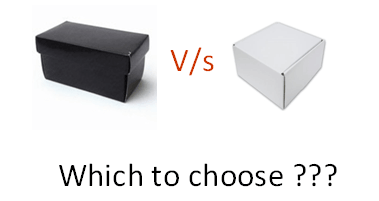Cos'è il NERO Box Test? Tecniche, tipi ed esempi
Nero Box Testing
Nero Box Testing è un metodo di test del software in cui le funzionalità delle applicazioni software vengono testate senza avere conoscenza della struttura del codice interno, dei dettagli di implementazione e dei percorsi interni. Nero Box Il test si concentra principalmente sull'input e sull'output delle applicazioni software ed è interamente basato sui requisiti e sulle specifiche del software. È noto anche come test comportamentale.
Quanto sopra Nero-Box può essere qualsiasi sistema software che desideri testare. Ad esempio, un sistema operativo come Windows, un sito web come Google, un database come Oracle o anche la tua applicazione personalizzata. Sotto il nero Box Test, puoi testare queste applicazioni concentrandoti solo sugli input e sugli output senza conoscere l'implementazione del loro codice interno. Considera il seguente tutorial video:
Clicchi qui se il video non è accessibile
Importance and Advantages of Black Box Testing
Nero Box Testing plays a crucial role in ensuring that a software product works exactly as end-users expect—without needing to know how it’s built. It evaluates a system’s functionality based on inputs and outputs, focusing on what the software does rather than how it does it.
This approach mirrors real-world usage, allowing testers to think like users, not developers. It’s especially effective in validating user experience, integration with external systems, and business logic correctness. In short, Nero Box Testing bridges the gap between user expectations and technical implementation.
👉 Enroll for Free Live Black Box Testing
Nero Box Tecniche di prova
The following are the prominent Strategie di prova among the many used in Black box Testing
- Test della classe di equivalenza: It is used to minimize the number of possible test cases to an optimum level while maintaining reasonable test coverage.
- Test del valore limite: Boundary value testing is focused on the values at boundaries. This technique determines whether a certain range of values is acceptable by the system or not. It is very useful in reducing the number of test cases. It is most suitable for systems where the input is within certain ranges.
- Decision Table Testing: A decision table puts causes and their effects in a matrix. There is a unique combination in each column.
Tipi di nero Box Testing
Esistono molti tipi di Nero Box Testing, but the following are the prominent ones –
- Test funzionali – Questo tipo di test della scatola nera è correlato ai requisiti funzionali di un sistema; viene eseguito dai tester del software.
- Test non funzionali – This type of black box testing is not related to testing of specific functionality, but non-functional requirements such as performance, scalability, and usability.
- Test di regressione – Regression Testing is done after code fixes, upgrades, or any other system maintenance to check that the new code has not affected the existing code.
Come fare il neroBox Test in ingegneria del software
Ecco i passaggi generici seguiti per effettuare qualsiasi tipo di Nero Box Testing.
- Inizialmente vengono esaminati i requisiti e le specifiche del sistema.
- The tester chooses valid inputs (positive test scenario) to check whether SUT processes them correctly. Also, some invalid inputs (negative test scenario) are chosen to verify that the SUT is able to detect them.
- The tester determines expected outputs for all those inputs.
- Il tester del software costruisce casi di test con gli input selezionati.
- I casi di test vengono eseguiti.
- Il tester del software confronta i risultati effettivi con quelli previsti.
- Defects, if any, are fixed and re-tested.
Strumenti utilizzati per il Nero Box Test:
Tools used for Black box testing largely depend on the type of black box testing you are doing.
- Per i test funzionali/di regressione è possibile utilizzare – QTP, Selenium
- Per i test non funzionali, è possibile utilizzare: LoadRunner, JMeter
Vantaggi e Svantaggi della
Like every testing approach, however, Black Box Testing comes with its own set of strengths and limitations. Understanding both sides helps teams decide when and how to apply it effectively within the testing lifecycle.
vantaggi:
- Approccio orientato all'utente
- Nessuna conoscenza di programmazione richiesta
- Independent and Objective
- Effective for Large Applications
svantaggi:
- Limited Test Coverage
- Inefficient for Deep-Level Bugs
- Difficult Root Cause Analysis
- High Dependency on Requirement Quality
Challenges in Black Box Testing (and How to Overcome Them)
Nero Box Testing offers great value for validating functionality and user experience—but it’s not without hurdles. Since testers can’t see inside the system, diagnosing or covering every scenario can be tricky. Below are common challenges and practical ways to overcome them.
| La sfida | Come superarlo |
|---|---|
| Limited Visibility of Code | Combine with White/Gray Box Testing to trace logic-level bugs. |
| Dependence on Clear Requirements | Utilizzare Matrice di tracciabilità dei requisiti (RTM) to ensure full coverage. |
| Incomplete Test Coverage | Apply Equivalence Partitioning & Boundary Value Analysis to reduce redundancy. |
| Time-Consuming for Large Systems | Utilizzare strumenti di automazione come Selenium or Katalon for efficiency. |
| Difficult Debugging | Involve developers early for joint defect triage and quick root-cause analysis. |
| Dynamic Interfaces & Frequent Changes | Implement Continuous Integration (CI) to keep tests updated automatically. |
| Ambiguous Expected Results | Encourage cross-functional reviews to clarify acceptance criteria. |
| Limited Security/Performance Insight | Add penetration and performance testing to complement black box methods. |
When Not to Use Black Box Testing
Mentre Nero Box Testing is ideal for validating functionality and user behavior, it’s not suitable for every testing scenario. Because testers have no visibility into the internal logic or code, certain defects and performance issues can remain undetected. Below are the situations where alternative testing approaches—like White Box or Gray Box Testing—work better.
| Situazione | Perché Nero Box Testing Isn’t Ideal | Alternativa migliore |
|---|---|---|
| 1. Unit or Component-Level Testing | Requires internal code knowledge to test individual modules or logic paths. | Bianco Box Testing |
| 2. Debugging or Root Cause Analysis | Nero Box only reveals failures, not the reason behind them. | Bianco Box Testing |
| 3. Algorithm or Logic Validation | Internal logic and data flow can’t be verified from outputs alone. | Bianco Box / Gray Box Testing |
| 4. Performance or Load Testing | Doesn’t measure code-level efficiency, resource use, or optimization. | Cookie di prestazione / Test di stress |
| 5. Security Testing at Code Level | Lacks visibility to identify vulnerabilities within source code or API layers. | Static Code Analysis (SAST) |
| 6. Incomplete or Ambiguous Requirements | Without clear functional specs, testers can’t design effective black box tests. | esplorativa or Ad-hoc Testing |
| 7. Continuous Debugging in Agile Sprints | Frequent code changes require internal validation for faster fixes. | Gray Box Testing |
Confronto del nero Box e bianco Box Test:
| Nero Box Testing | Bianco Box Testing |
|---|---|
| The main focus of black box testing is on the validation of your functional requirements. | Bianco Box Testing (Unit Testing) validates the internal structure and working of your software code |
| Black box testing gives abstraction from code and focuses on testing effort on the software system’s behavior. | Per condurre White Box Testing, knowledge of the underlying programming language is essential. Current-day software systems use a variety of programming languages and technologies, and it’s not possible to know all of them. |
| Il test della scatola nera facilita la comunicazione di test tra i moduli | Il test della scatola bianca non facilita la comunicazione di test tra i moduli |
Real-World Examples of Black Box Testing
Nero Box Testing is used across industries to validate how software behaves from a user’s perspective—without peeking into the code. It’s applied in web, mobile, and enterprise systems to ensure smooth functionality, security, and user experience.
| Scenario | Cosa è stato testato | Esempio Descriptione |
|---|---|---|
| 1. Login Functionality Testing | Input validation, authentication | A tester enters valid and invalid credentials to confirm login success and proper error messages. |
| 2. E-commerce Checkout Process | Workflow, payment, error handling | Verifies if users can add items to cart, apply coupons, and complete payment successfully. |
| 3. Banking Application | Transaction validation, boundary testing | Ensures correct balance updates, transaction limits, and error handling for invalid inputs. |
| 4. Mobile App Usability | UI/UX behavior, navigation flow | Tests app responsiveness, button interactions, and user flow consistency across devices. |
| 5. Online Form Submission | Input validation, data integrity | Checks that required fields, formats, and error prompts work as intended (e.g., email or phone validation). |
| 6. API Endpoint Testing (Black Box Stile) | Input/output response accuracy | Sends requests without viewing backend code to ensure correct status codes and data output. |
| 7. Video Streaming Platform | Performance under load, error recovery | Tests if video playback adjusts quality dynamically and handles buffering properly. |
Nero Box Ciclo di vita di test e sviluppo software (SDLC)
Il test della scatola nera ha un proprio ciclo di vita chiamato Ciclo di vita del test del software (STLC), and it is relevant to every stage of the Ciclo di vita dello sviluppo del software di Ingegneria del Software.
- Requisito – This is the initial stage of SDLC, and in this stage, a requirement is gathered. Software testers also take part in this stage.
- Pianificazione e analisi dei test - Tipi di test applicabili al progetto. UN Piano di test is created, which determines possible project risks and their mitigation.
- Progettazione – In this stage, Test cases/scripts are created on the basis of the software requirement documents
- Esecuzione del test– In this stage Test Cases prepared are executed. Bugs, if any, are fixed and re-tested.
Domande frequenti
Summary: Key Takeaways on Black Box Testing
- Nero Box Testing focuses on validating software behavior through inputs and outputs—without viewing internal code.
- It’s also called Behavioral Testing, as it mirrors how end-users interact with applications.
- . tipi principali include Functional, Non-Functional, and Regression Testing, covering usability, performance, and stability.
- Uncommon tecniche: Equivalence Partitioning, Boundary Value Analysis, Decision Table Testing, State Transition Testing, and Error Guessing.
- vantaggi: user-centric validation, no need for coding knowledge, strong system-level coverage, and automation compatibility.
- svantaggi: limited internal visibility, reliance on clear requirements, and difficulty pinpointing root causes.
- Ampiamente usato in web, mobile, and enterprise testing to ensure real-world usability and reliability.
- migliori results come from combining Black Box with White or Gray Box Testing per una copertura completa.
- To maximize efficiency, follow best practices—clear requirements, automation, prioritized scenarios, and regular updates.
- Ultimately, Black Box Testing ensures that software behaves exactly as users expect, delivering a seamless, error-free experience.



